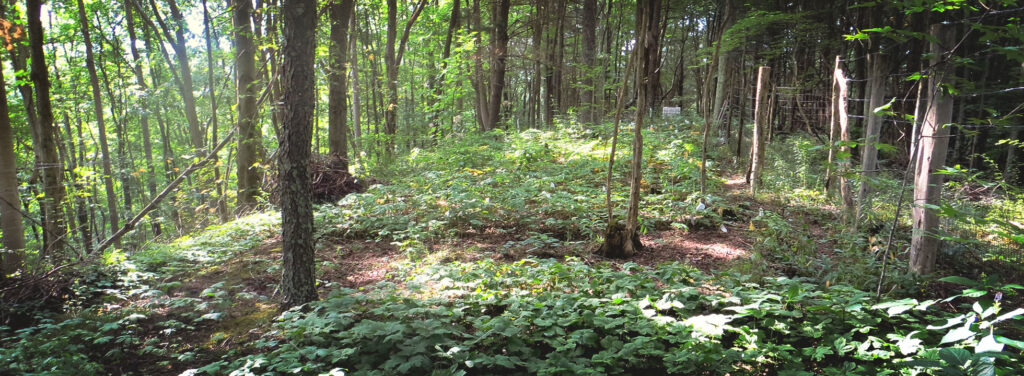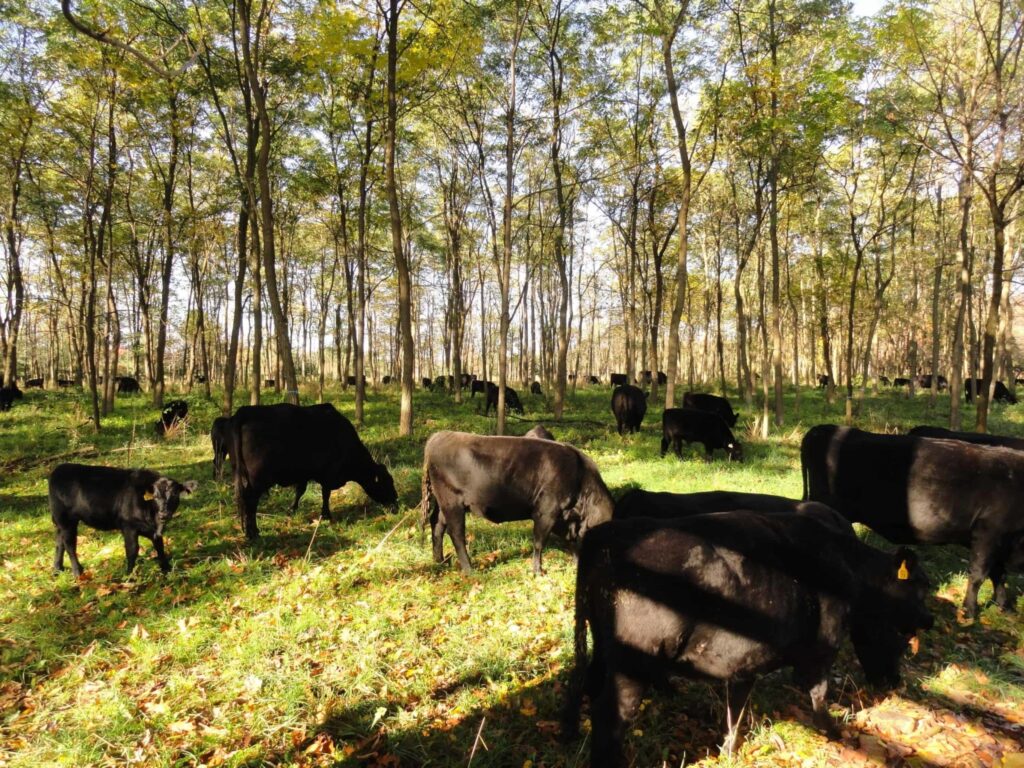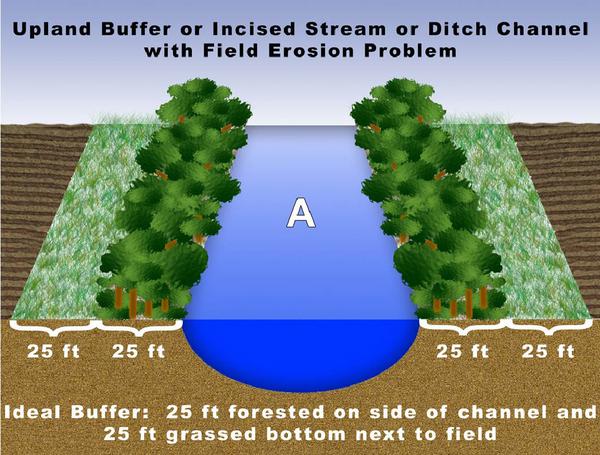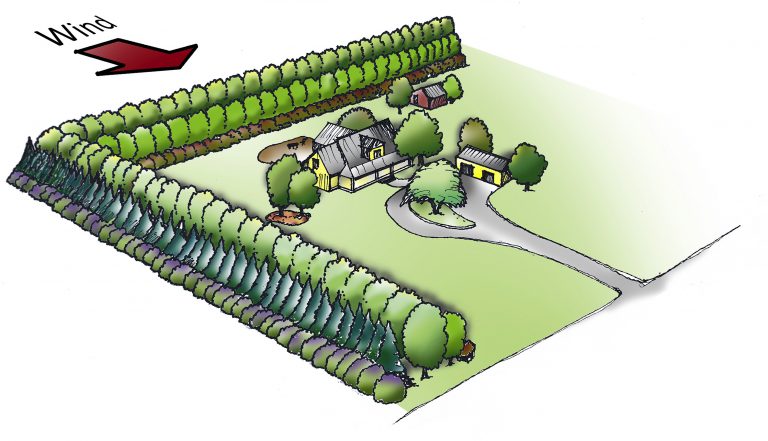By Clare Kelly

An Introduction to Agroforestry:
Some major issues facing the agricultural industry include increasing biodiversity, maintaining soil health, and resiliency to climate change. When most people think of agrosystems, they usually think about fields, rows of crops, or livestock wandering in a pasture, but they rarely think about the importance of trees, shrubs, and plants to the health of a farming system. Trees however, provide numerous benefits ecologically and economically to agroecological systems and can be incorporated into farming through various practices that each have a unique ecological and economical purpose. Agroforestry, or the integration of trees and shrubs into livestock and crop systems, has many benefits and helps promote healthy soil, pastures, and forests which allows for diversified farm systems with greater economic opportunity.
How is Agroforestry Integrated into Farm Systems?
Agroforestry is a multifaceted component of farm systems that includes various different practices that integrate forestry into an agroecological system. Some examples of agroforestry practices include:
Alley Cropping:
Alley cropping involves planting crops in between rows of trees, these are often orchard trees and allow for income from crops while trees mature. Alley cropping can also be done with shrubs as it creates alleys for growing crops.
- Alley cropping can increase yield because having trees or shrubs improves soil health and reduces erosion and wind.
- Trees also produce organic matter that improves the soil health and microbial diversity.
- Some options for crops to grow in an alley cropping system include cereal crops such as corn soybeans or oats.
- Shade tolerant forage crops can be different grasses, clover, or alfalfa to produce for forage.
Forest Farming:
This practice is an efficient use of land where shade tolerant herbal, botanical, or decorative crops can be grown under the canopy of a stand of trees.
- Crops grown under the forest canopy are often called Non-Timber Forest products, also known as NTFPs and include crops like shiitake mushrooms, ginseng, and goldenseal.
- This practice diversifies income sources as timber can also be harvested, especially on rich sites that support forest farming where high quality trees can grow.
- This is most often a practice used on private family forest lands as supplementary income.

Silvopasture:
Silvopasture is a practice for livestock operations that is growing in popularity which combines trees with livestock and forage in one place. This provides timber value, allows for sustained soil health, nutrient cycling, and shades animals from the conditions.
- Silvopasture can be integrated into woodlands or trees can be planted in an existing pasture. When a forest is already there thinning must occur so that there is space for livestock and forage can still get light on the forest floor.
- Alternatively, fast growing trees such as black locusts can be planted in rows like orchards or clusters where they fix nitrogen and maintain a healthy soil microbiome for forage growth.
- Choosing the correct animals and rotating them is essential to maintaining soil health, tree health, and substantial forage.
- As trees mature, they can be cut for timber or the land can be restored to forest and be cut later for profit.
- Silvopasture is a great practice but takes management inputs such as ensuring animals are rotating, pruning trees, weed and invasive control, and managing for tree pests and diseases.

Riparian Buffers:
Practices from forestry can also be used. These include practices such as riparian forest buffers which maintain stream health and mitigate run off from farm fields.
- Riparian buffers are areas next to wetlands, streams or lakes that are made up of trees, shrubs, or perennial plants that limit erosion, maintain bank stability, and help control the microclimate of the soil and protect water quality and watershed health.
- Riparian buffers are also important to aquatic wildlife, as having trees next to streams allows for organic matter to be deposited into the stream and provide food for organisms if it is a heterotrophic stream (a heterotrophic stream is one where organisms rely on external inputs for food).
- Additionally, downed woody material can create necessary habitat for various critical species such as salmon.

Windbreaks:
Another forestry practice adopted for agroforestry purposes is windbreaks.
- Windbreaks involve single or multiple rows of trees that serve to protect crops, soil, or livestock from conditions and improve the quality of life for both farmers and animals on a farm.
- Windbreaks can also reduce noise and smells coming from livestock operations which benefits those around farms.
- By protecting crops from harsh conditions, it can increase yield significantly.

Agroforestry is a practice that has various pathways, but is focused on overall ecosystem health by integrating trees and forests into agrosystems to promote ecological and economic diversity.
Ecological Benefits of Agroforestry Practices:
Alley cropping:
- Alley cropping can improve agrosystems by immediately improving biodiversity and by having significant impacts on soil health, especially in nutrient poor tropical regions.
- Alley cropping can involve planting trees or shrubs that are nitrogen fixing such as black locusts, or other trees in the legume family, which adds N to the soil where it may have been depleted from plants that need large amounts of it.
- Alley cropping also improves soil health by improving nutrient cycling due to the addition of litterfall (leaves and pruned leafy matter).
- With this increased organic matter in the soil it can help with soil aeration, erosion control, and decreasing nutrient leaching, all of which can help regenerate topsoil that has been degraded from tilling crops (Hombegowda et al. 2022).
Silvopasture:
- According to one study, silvopasture can be beneficial to soil health and overall farm system health because of its positive effects on forage and soil microclimate
- Silvopasture can improve this because of the natural fertilizer from livestock animals as well as the partial shading from trees which is optimal for various native forage species.
- Additionally, silvopasture can restore threatened ecosystem types.
- Some growers report that silvopasture helped restore oak savana in Wisconsin and Minnesota, oak rangelands in California and long leaf pine in Alabama (Smith et al., 2021).
- Livestock eat many of the plants that serve as competition for these species when regenerating and create a unique microclimate that certain species can compete well in.
- When comparing pasture to silvopasture, silvopastures are more diverse and add diversity of microbial communities, insects, and fungi to an agrosystem.
- Additionally, when animals are given antibiotics and they’re excreted into the soil it can be a water quality risk, but one study showed that eastern cottonwoods in silvopastures have the ability to mitigate antibiotics loss from the soil due to the microbial enzymatic activity associated with their root systems.
- Silvopasture can diversify farm systems and improve soil health through the use of various tree species.

Forest Farming:
- Forest farming can greatly improve biodiversity and add value to existing productive timber lands and family forests.
- Woodlots owned by farmers are often smaller and unmanaged, so introducing forest farming can improve forest health and biodiversity by introducing thinning which will open space and resources for existing trees, regeneration, and forest farming crops such as ginseng.
- One study in the Damar Agroforests of Sumatra, Indonesia found that “these complex multistrata agroforests contain over 50% of all the regional pool of resident tropical forest birds, most of the mammals and about 70% of the plants” (Leakey).
- Due to the complex structure (various ages and types of trees) in these agroforests that mimic natural tropical forests, there is an abundance of habitat and food for various species to live here.
- This is a prime example of the sustainability of forest farming and how it improves biodiversity.
Windbreaks:
- Some species planted in windbreaks such as dogwoods and other native shrub species can be helpful to pollinators and provide food sources at different times depending on when they bloom, further increasing biodiversity.
- In temperate regions, windbreaks can protect crops and livestock from blowing snow, provide refuge for insects, birds, and other wildlife, and help maintain a consistent microclimate under changing climate conditions.
- The microclimate of the soil and sheltered areas are protected by windbreaks because they naturally limit wind and rain, allowing for increase temperature and lower evaporation rates which improves crop growth and soil health.
- Windbreaks provide habitat and improve the health of agrosystems while economically protecting resources such as crops and livestock.
Riparian Buffers:
- Commonly used in forest management, riparian buffers are key to maintaining healthy watersheds and protecting streams, rivers, lakes, and all bodies of water from agricultural runoff.
- These buffers are also places where biodiversity can flourish. Often created around wetland areas and places with rare or endangered terrestrial and aquatic species, they improve biodiversity by protecting these plants and animals.
- Multi-species buffers can integrate native grasses, forbs, shrubs, and slow-growing as well as fast growing trees to diversify the buffer and limit the spread of disease and pests.
- As one study found, grasses and forbs restore soil quality by adding carbon to the soil from the turnover of roots that contain “more than 70% of the total biomass of the prairie plants”(Schultz et al., 2004).
- Additionally, litterfall from trees further add carbon sources and diversify the soil profile
- Overall, riparian buffers improve water quality by limiting erosion and runoff, improve soil health, and create resilient ecosystems within the larger farming system.
Conclusion:
Agroforestry is a diverse and wide-ranging practice that can be implemented on the small scale of family farms and forests up to industrial agriculture lands. It is made up of various practices such as forest farming where crops are integrated into existing forested lands, silvopasture where rotating livestock and trees occupy the same land, windbreaks of trees and shrubs to protect livestock and crops, alley cropping where crops and trees coexist, and riparian buffers along bodies of water to protect watershed health. Overall, agroforestry can help farmers build thriving agroecosystems by incorporating trees into their crop and livestock production practices to enhance soil health, farm resiliency and biodiversity in the face of climate change.
Sources:
Fransen, Bas. “What Is Agroforestry?” EcoMatcher, 21 Jan. 2020, www.ecomatcher.com/what-is-agroforestry/.
Gabriel, Steve. “Six Key Principles for a Successful Silvopasture.” Cornell Small Farms, 28 June 2018, smallfarms.cornell.edu/2018/06/six-key-principles-for-a-successful-silvopasture/.
Hombegowda, H.C., et al. “Alley Cropping Agroforestry System for Improvement of Soil Health.” Environmental Science and Engineering, vol. 1, 1 Jan. 2022, pp. 529–549, https://doi.org/10.1007/978-3-031-09270-1_23. Accessed 14 Dec. 2023.
Jose, Shibu, et al. “Ecological Considerations in Sustainable Silvopasture Design and Management.” Agroforestry Systems, vol. 93, no. 1, 6 Jan. 2017, pp. 317–331, https://doi.org/10.1007/s10457-016-0065-2.
Kafer, Nathan, and South. AGROFORESTRY NOTES Windbreaks: An Agroforestry Practice. 2022.
Macfarland, Kate, and Assistant Agroforester. Alley Cropping #1 AGROFORESTRY NOTES Photo Credit: Mike Gold Alley Cropping: An Agroforestry Practice. 2017.
Roger R.B. Leakey. “Agroforestry for Biodiversity in Farming Systems.” International Tree Foundation, UK, 14 Aug. 1998, https://doi.org/10.1201/9781420049244.ch8.
Schultz, R.C., et al. “Riparian Forest Buffers in Agroecosystems – Lessons Learned from the Bear Creek Watershed, Central Iowa, USA.” Agroforestry Systems, vol. 61-62, no. 1-3, July 2004, pp. 35–50, https://doi.org/10.1023/b:agfo.0000028988.67721.4d. Accessed 18 Mar. 2020.
Smith, Matthew M., et al. “Silvopasture in the USA: A Systematic Review of Natural Resource Professional and Producer-Reported Benefits, Challenges, and Management Activities.” Agriculture, Ecosystems & Environment, vol. 326, Mar. 2022, p. 107818, https://doi.org/10.1016/j.agee.2021.107818.
USDA. “Agroforestry.” Usda.gov, 2019, www.usda.gov/topics/forestry/agroforestry.
USDA. “Forest Farming.” Www.fs.usda.gov, www.fs.usda.gov/nac/practices/forest-farming.php.
USDA. “Riparian Forest Buffers.” Usda.gov, 2014, www.fs.usda.gov/nac/practices/riparian-forest-buffers.php.
UW-Madison Extension Forestry. “Windbreaks – Agroforestry for Any Property – UW-Madison Extension Forestry.” Woodlandinfo.org, woodlandinfo.org/windbreaks/.